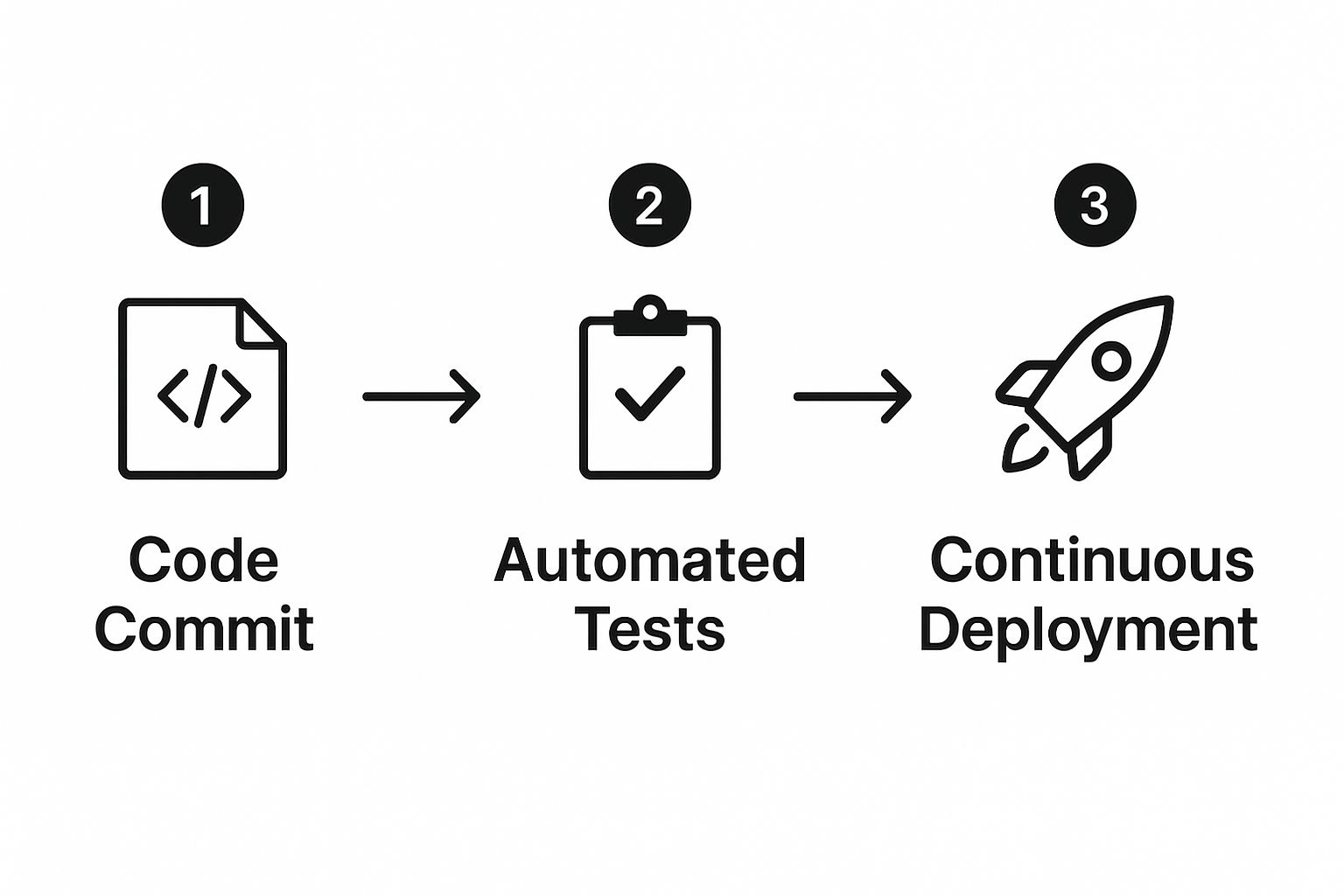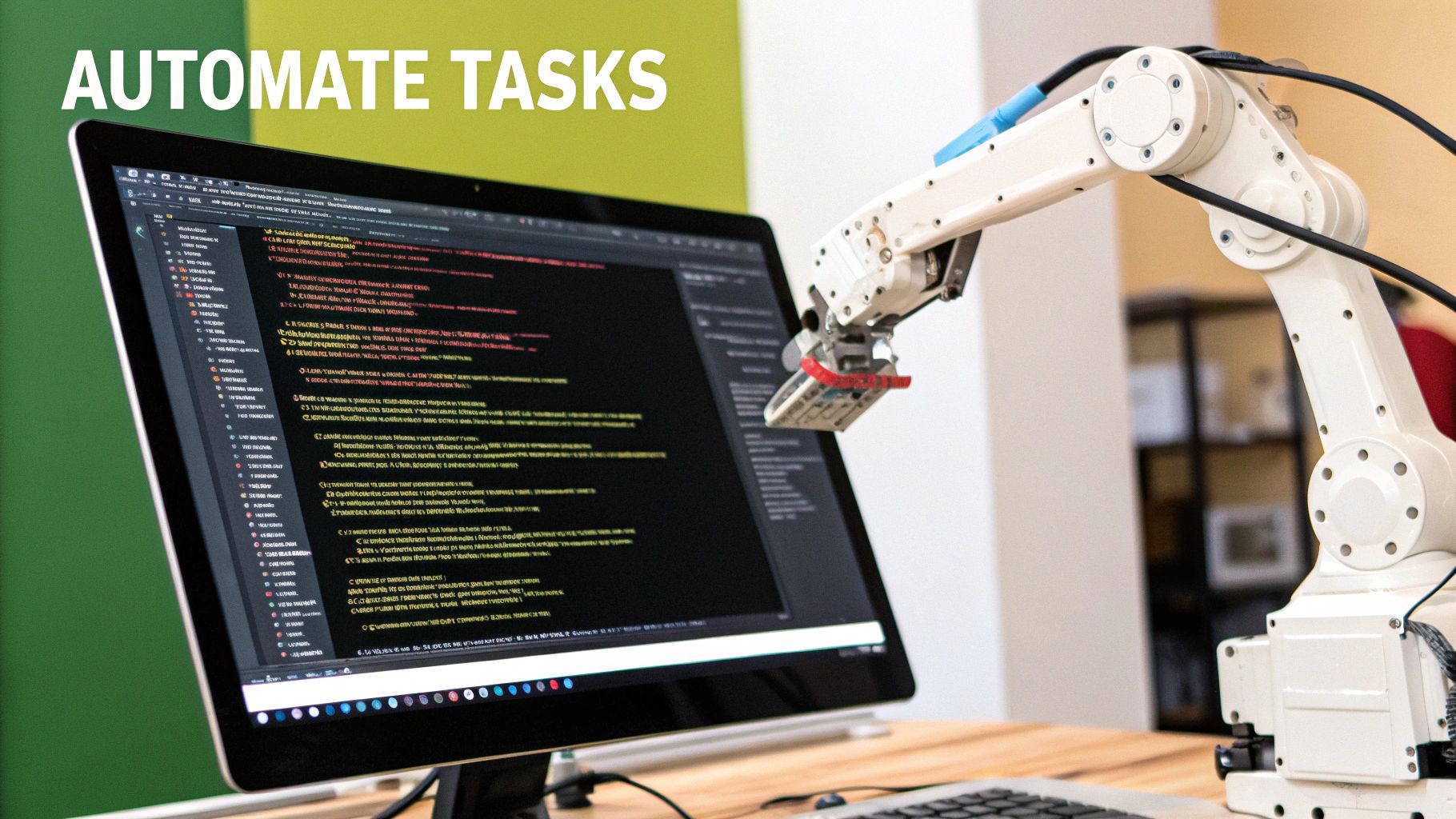How to Improve Developer Productivity: Tips & Strategies
- Ron Smith

- Jul 21
- 13 min read
Let's be honest—measuring developer productivity by counting lines of code is a relic. If you're still doing it, you're missing the point entirely.
True productivity isn't about pushing developers to work faster; it's about helping them work smarter. The real key to boosting your team's output is building an ecosystem that prioritizes innovation and efficiency over raw code volume. It’s about combining smart tech with modern ways of managing talent, particularly emerging trends in workforce management and contingent labor.
Moving Beyond Outdated Productivity Metrics

The conversation around developer productivity has finally grown up. For decades, managers clung to simplistic, frankly lazy metrics like lines of code (LOC) or the number of commits. They're easy to count, sure, but they tell a dangerously misleading story.
Think about it. Those metrics actually reward bloated, hard-to-maintain code and punish the very thing you want: elegant, efficient solutions that solve problems with fewer lines.
Real productivity is so much bigger than that. It covers the entire software development lifecycle—from the first spark of an idea to deployment and ongoing maintenance. It's about empowering your developers to solve tough problems without getting bogged down by friction and red tape.
The Modern Pillars of Productivity
Today's high-performing teams have shifted their focus to a more holistic set of principles that actually drive results. If you’re serious about improving developer productivity, these are the pillars you need to build on.
Efficient Workflows: This means killing context switching, automating every repetitive task you can find, and building CI/CD pipelines so smooth they’re almost invisible. The goal is simple: remove the roadblocks and let developers get into that state of deep work, or "flow."
Intelligent Technology: Advancements in AI, like coding assistants and advanced low-code platforms, are no longer a novelty; they're a massive advantage. These tools don't replace your developers. They supercharge them, handling the grunt work and freeing them up to focus on high-impact problems.
Supportive Culture: You can't squeeze productivity out of a team that's burned out or afraid to fail. A culture that champions psychological safety, continuous learning, and developer well-being is non-negotiable. When developers feel trusted and autonomous, their engagement and motivation skyrocket.
Strategic Workforce Management: The old hiring models are broken. An emerging trend is a new kind of staff augmentation that leverages contingent labor, giving you on-demand access to a global talent pool. This isn't just about filling seats; it's about injecting specialized skills into your team with incredible flexibility, often at the most affordable cost.
The challenge for today's leaders is to look past the code and see the entire system. Productivity isn't a single number on a dashboard. It's found in the health of your development ecosystem—your people, your processes, and your tools.
This table breaks down the modern approach, moving the focus from just raw output to genuine, holistic effectiveness.
Core Pillars of Modern Developer Productivity
Pillar | Description | Key Metric Examples |
|---|---|---|
Efficient Workflows | Minimizing friction and context switching to enable deep work. Involves seamless CI/CD, automation, and clear processes. | Cycle Time, Deployment Frequency, Change Failure Rate, Mean Time to Recovery (MTTR) |
Intelligent Technology | Augmenting developer capabilities with AI assistants, advanced tooling, and low-code platforms to accelerate development. | AI Code Suggestion Acceptance Rate, Time Saved on Repetitive Tasks, Reduction in Rework |
Supportive Culture | Fostering psychological safety, continuous learning, and well-being to boost engagement and innovation. | Developer Satisfaction (eNPS), Retention Rate, Team Morale Surveys, Pull Request Comment Sentiment |
Strategic Workforce | Using flexible talent models, like a new kind of staff augmentation, to access specialized global skills and scale teams effectively at an affordable cost. | Time to Fill Critical Roles, Access to Niche Skills, Project Velocity, Cost per Feature |
Getting this right is more critical than ever, especially when you look at the numbers. The global developer population has absolutely exploded, surging from an estimated 24 million in 2022 to a projected 47.2 million by 2025.
This isn't just a fun fact; it's a signal. This growth highlights our massive reliance on software and the urgent need to get smarter about how we build and manage our technical teams. You can learn more about these global developer population trends to see just how fast things are changing.
Creating a Frictionless Development Workflow
A developer's most valuable asset isn't a fancy keyboard or a second monitor—it's focused, uninterrupted time. So when a study reveals that 46% of developers spend 20 hours or less each week on actual development, something is deeply wrong.
That’s a staggering amount of potential being flushed away. The culprits? Administrative overhead, endless meetings, and clunky processes that inject friction at every turn. To get that time back, you have to become a relentless hunter, sniffing out and eliminating these bottlenecks from your software development lifecycle (SDLC).
A frictionless workflow isn't some nice-to-have perk; it's a competitive necessity. It's about creating an environment where developers can hit that "flow state" without getting yanked out by manual chores or confusing procedures. This means a fundamental shift: from micromanagement to empowerment, and from manual grunt work to intelligent automation.
Streamlining the Path to Production
The journey from a code commit to a live deployment should be so smooth it's almost boring. This is where DevOps principles and a solid CI/CD (Continuous Integration/Continuous Deployment) pipeline become your best friends. By automating builds, tests, and deployments, you rescue developers from soul-crushing manual steps that are just begging for human error.
This diagram shows just how clean a well-oiled CI/CD pipeline can be, streamlining everything from the initial commit to the final deployment.

Automating these stages means every single code change is consistently tested and deployed. The result? A dramatic drop in bugs and a much faster delivery cadence. The goal is to make deployment a non-event—a routine, predictable process, not a high-stress, all-hands-on-deck emergency.
Reimagining Code Reviews and Collaboration
Code reviews are another classic source of friction. Handled badly, they become a major bottleneck. We've all seen it: a pull request sits gathering dust for days, blocking progress and killing momentum. A productive code review is a constructive collaboration, not a gatekeeping ritual.
To make that happen, you need to establish clear ground rules:
Set Time Limits: Don't let reviews linger. Aim for a maximum turnaround time—say, 24 hours—to keep things moving.
Focus on What Matters: Reviews should catch architectural flaws and logic errors. Arguing over code style? That's what linters are for. Automate it.
Keep Pull Requests Small: Small, focused PRs are infinitely easier and faster to review. This encourages a rapid feedback loop and keeps developers engaged.
The core idea is to treat code reviews as a learning opportunity, not an evaluation. This builds psychological safety, encouraging developers to share work early and often without fearing harsh criticism.
For teams moving at high speed, embracing methodologies like Rapid Application Development (RAD) can seriously accelerate software delivery and help forge a truly frictionless environment.
Ultimately, a frictionless workflow comes down to respecting your developers’ time and cognitive energy. This isn't just a process tweak; it's a foundational step in building a high-performing team. As your organization grows, maintaining this efficiency becomes even more critical. To learn more about how to scale without sacrificing agility, check out our guide on scaling engineering teams without the chaos.
When you remove the friction, you empower developers to do what they do best: solve complex problems and create real value.
Getting An Edge With AI And Low-Code

These tools are built to automate the tedious stuff—the boilerplate code, the repetitive tasks, and even suggesting fixes for gnarly problems. This pulls your senior developers out of the weeds and lets them focus on what they do best: solving high-level architectural puzzles and driving real business innovation.
This isn’t some far-off future, either. It’s happening right now. A staggering 92% of US developers are already using AI coding tools. And it’s projected that by 2025, a massive 70% of new business applications will be built with low-code or no-code tech. This is a sea change in software creation.
Weaving In AI and Low-Code Without Chaos
Dropping these new tools on your team with a top-down mandate is a recipe for disaster. You need a thoughtful approach. The goal is to make your team better, not to create friction where there wasn't any before.
I’ve seen this work best when you start small. Kick off a pilot program with a handful of enthusiastic devs. Let them experiment with a new tool on a non-critical project. This gives them a low-stakes sandbox to figure out what works, find the gotchas, and build some early wins.
That initial success creates momentum. Their practical lessons become the playbook for a wider, smoother rollout.
The secret is framing these tools as partners, not replacements. When developers see AI as an assistant that helps them ship better code faster, adoption becomes natural. Enthusiasm builds on its own.
Democratizing Development, Unlocking Innovation
One of the biggest wins here is the democratization of development. Low-code platforms empower people outside your core engineering team—think business analysts, product managers, or even marketing pros—to build their own simple apps and internal tools.
This pays off in two huge ways:
It shrinks the backlog. Simple requests that used to clog up the engineering queue get handled by the teams that need them. Your developers are free to tackle the complex, high-value work that truly requires their expertise.
It sparks innovation. Ideas can be prototyped and tested in days, not months. The marketing team can spin up a custom landing page for a new campaign. HR can build an automated onboarding workflow. All without writing a line of code.
If you really want to get ahead, exploring the potential of no-code artificial intelligence can open up even more possibilities for rapid, code-free innovation.
By strategically combining AI assistants for your core developers with low-code platforms for the rest of the organization, you build an ecosystem where everyone is empowered to be more productive. That’s how you build a modern, high-velocity tech organization.
Building a Culture That Fosters Productivity
You can have the most sophisticated tools and the slickest CI/CD pipelines in the world, but they won't mean a thing if your company culture is broken. When we talk about boosting developer productivity, the conversation has to start with people, not just code. A culture that genuinely supports deep work and motivation is the engine that drives everything else.
The bedrock of this kind of culture? Psychological safety. It’s that shared, unspoken belief that you can take a risk, ask a "stupid" question, or even admit you screwed up without facing humiliation or blame. When your developers feel secure enough to experiment and fail, that's where true innovation comes from. Real breakthroughs don't happen when people are afraid to step out of line.
This sense of security is the ultimate antidote to micromanagement. When leaders set clear goals but then trust their teams to figure out the how, it sends a powerful message. That autonomy is a huge driver of engagement and intrinsic motivation—the desire to do good work for its own sake.
Protect Your Team's Focus at All Costs
One of the most critical—and often overlooked—jobs of a manager is to be a shield. You have to fiercely protect your team's time and focus. The real magic happens during long, uninterrupted stretches of "flow state," and that state is incredibly fragile. A single Slack ping or unnecessary meeting can shatter it completely.
This means you need to be the one pushing back against meeting creep and administrative fluff. For a wider lens on this, it’s worth looking into some clever ways to increase your team's productivity that can apply far beyond just the engineering department.
Here’s how you can create an environment where deep work can actually happen:
Block out "No-Meeting" zones. Seriously. Dedicate specific hours or even entire days where developers can code without a single interruption.
Default to async. Push your team to use tools for updates and questions that don't demand an instant reply. This lets developers engage on their own schedule.
Make goals painfully clear. Every single developer should know exactly what they need to build and why. Clarity kills the kind of wasted effort that ambiguity creates.
Cultivate Growth and Actually Recognize It
A productive culture is a learning culture. It's that simple. Technology moves too fast for anyone to stand still. If you’re not providing opportunities for continuous growth—whether it's sending people to conferences, paying for training, or just carving out time for R&D—you're telling your team you're not invested in them.
And just as important: recognize what matters. I'm not just talking about shipping features on time. Celebrate the developer who mentors a junior engineer, the one who finally untangles a decade of technical debt, or the person who writes documentation that actually helps people. Those contributions strengthen the entire team and are often thankless. Don't let them be.
Building a supportive ecosystem where feedback is constructive, goals are clear, and all types of contributions are valued is how you unlock that extra gear. It's how you create a place where developers want to do their best work.
Running a distributed team adds another layer of complexity, but the core principles don't change. In fact, fostering this kind of culture is one of our key 9 best practices for remote teams to scale in 2025. When you get the human element right, the productivity takes care of itself.
Leveraging Global Talent with Modern Staff Augmentation

Let's be honest, the old way of building an engineering team is broken. The model of local-only hiring, endless recruitment cycles, and fixed overhead just can't keep up. Forward-thinking companies are blowing past their city limits and embracing a much smarter, more dynamic approach to building their workforce, fueled by emerging trends in workforce management.
This new reality is built on contingent labor and a far more agile version of staff augmentation. Instead of treating every hire like a permanent, high-stakes commitment, modern leaders see team-building as a flexible, strategic tool. This opens the door to a global talent pool, letting you bring in hyper-specialized skills exactly when and where they're needed. This is the new kind of staff augmentation that offers access to global talent at the most affordable cost.
The New Shape of Staff Augmentation
Forget what you think you know about staff augmentation. Traditionally, it was just about plugging a temporary hole in the team. A seat-filler.
Today, it's a strategic service that delivers vetted, world-class developers on demand, often through a single, streamlined platform. This isn't about finding cheap labor; it's about gaining a serious competitive advantage by solving the core problems that kill developer productivity and stall growth.
What does that actually look like?
Access to Niche Skills: Need a developer with deep expertise in a specific machine learning framework or cloud platform? Instead of a six-month search, you can have a qualified expert integrated into your team in days.
Unmatched Flexibility: Project needs are never static. This modern augmentation model, a key trend in contingent labor, allows you to scale your team up for a major product push and then seamlessly scale back down without the HR nightmare of traditional hiring and firing.
Drastically Reduced Overhead: You completely sidestep the heavy costs tied to recruitment, onboarding, benefits, and local payroll for full-time hires. It’s an incredibly cost-effective way to get world-class global talent on your roster.
By decoupling talent from geography, you can assemble a dream team of developers from around the world. This isn't just a cost-saving measure; it's a powerful lever for boosting project velocity and overall productivity.
Integrating Augmented Developers for Success
Just adding a new developer to your Slack channel and calling it a day is a recipe for failure. If you want to unlock the real productivity gains, seamless integration is everything. The goal is to make augmented team members feel like a core part of your engineering culture from the moment they start.
Begin by treating them exactly as you would any other engineer. This means immediate access to your full documentation, CI/CD pipelines, and project management tools. They need to be in all the relevant meetings, code reviews, and brainstorming sessions. No exceptions.
Clear communication and well-defined goals are non-negotiable. Use your project management tools to assign crystal-clear tasks with explicit success criteria. Regular, structured check-ins help build rapport and ensure everyone stays aligned, completely avoiding the toxic "us vs. them" mentality that can poison a hybrid team.
For a deeper dive into the specific advantages, our guide on the [8 key staff augmentation benefits for tech leaders in 2025](https://www.shorepod.com/post/8-key-staff-augmentation-benefits-for-tech-leaders-in-2025) lays out a detailed roadmap.
By embracing this new era of staff augmentation, you aren't just hiring developers. You're building a more resilient, highly-skilled, and ridiculously productive engineering organization.
As you start to rethink how you approach developer productivity, some questions inevitably pop up. Let's get straight to the point and tackle the most common ones I hear from tech leaders.
What Metrics Actually Tell Me if My Team is Productive?
Forget about outdated and frankly, useless metrics like lines of code. It’s a vanity metric that tells you nothing about value.
Instead, you need to measure things that tie directly to business outcomes and how smoothly your development process runs. The gold standard here are the four DORA metrics. They give you a crystal-clear picture of your team's speed and stability.
Cycle Time: How long does it take for an idea to go from the first commit to being live in production? This is your core speed indicator.
Deployment Frequency: Are you shipping code multiple times a day, or once a quarter? High-performing teams release often.
Change Failure Rate: What percentage of your deployments blow up in production? This is your gut-check on quality.
Mean Time to Recovery (MTTR): When things do break (and they will), how fast can you fix them? This measures your team's resilience.
But numbers don't tell the whole story. You absolutely need to back this up with qualitative data. Regular developer satisfaction surveys are non-negotiable. They'll uncover the hidden frustrations, process bottlenecks, and morale issues that hard metrics will never show you.
How Do I Bring in AI Coding Tools Without Freaking Out My Team?
The last thing you want is for your team to feel like they're being replaced. The key here is a slow, collaborative rollout, not a top-down mandate.
Start with a pilot program. Grab a small, hungry group of developers who are genuinely excited about the tech. Give them a specific, contained project to test the AI tools on. Then, listen. Get their honest feedback—the good, the bad, and the ugly.
Frame AI as a powerful assistant, not a replacement. It's a tool to get rid of the soul-crushing boilerplate and grunt work, freeing them up to tackle the genuinely hard, interesting problems. This is one of the most practical advancements in technology for development teams today.
Use what you learn from that pilot group to build out some simple best-practice guides and focused training. This approach proves the value first and irons out the kinks before you go wide, which builds trust and encourages people to actually want to use the tools.
Is Staff Augmentation a Real Option for a Small or Mid-Sized Company?
Absolutely. In fact, modern staff augmentation is practically built for small and mid-sized companies. It's one of the most powerful ways to punch above your weight and compete with the big guys.
Think of it this way: this new kind of staff augmentation model gives you immediate access to a global pool of specialized, pre-vetted engineers without the soul-crushing overhead and long-term chains of traditional hiring.
You get the agility to spin up a team for a specific project and then scale it back down when you're done. This means you can tap into world-class talent, build faster, and stay nimble—all at the most affordable cost.
At shorepod, we've built our business around this new evolution of staff augmentation. Our Talent-as-a-Service platform connects you with vetted global engineering talent on-demand, giving you the competitive firepower you need without the ridiculous costs.
See how we can help you build your dream team.
Comments